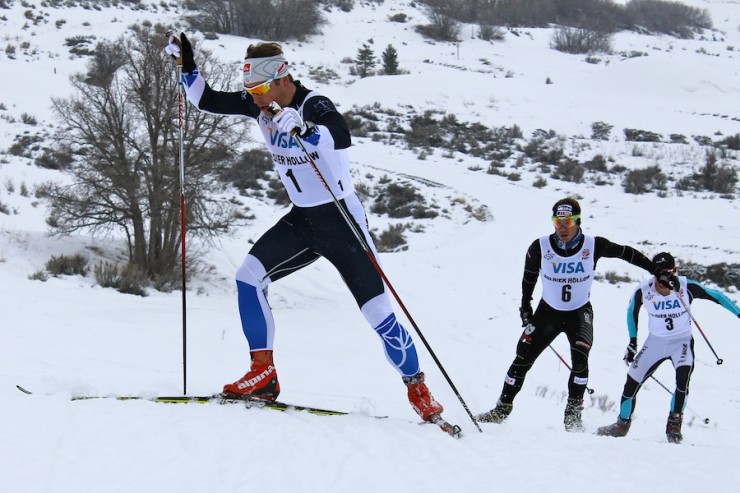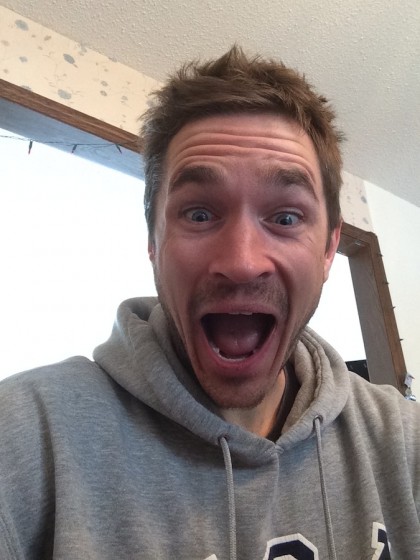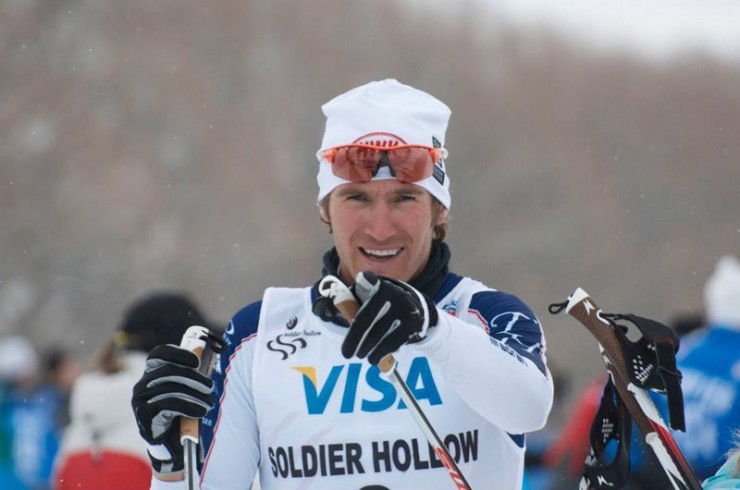
Three days ago, Matt Liebsch likened himself to the candy-striped ‘Where’s Waldo’ on Facebook. In the running for a distance spot on the U.S. Olympic nordic team, which is set to be named by Jan. 22, the 30-year-old Minnesota native wrote that he was “taking everything into consideration” and trying to figure out which races gave him the best chance to make the cut.

He had trekked up to the Rocky Mountain Intercollegiate Ski Association (RMISA) opener in Bozeman, Mont., last weekend, where he placed third in Sunday’s 10-kilometer freestyle.
An independent skier affiliated with XC United/Team StrongHeart, Liebsch is hardly alone in the hunt for one of few remaining openings for the Winter Games from Feb. 7-23 in Sochi, Russia. On Wednesday, he updated his page with the news that the U.S. picked up an additional Olympic quota spot for a grand total of 17.
“The strength of our nation is up there!” he wrote.
Ten of those slots are all but officially locked up by the U.S. Ski Team members who have been in Europe for the last two months. That leaves the possibility of seven openings up for grabs, but chances are, the USST isn’t going to take nearly that many additional athletes with utility skiers like Kikkan Randall, Sadie Bjornsen and Jessie Diggins that can compete in several events — both sprint and distance.
While the depth and strength of the U.S. women’s team is well documented, most of the stateside skiers trying to earn their tickets to Sochi, Russia, are men. And with one qualified distance guy on the USST, Noah Hoffman, it would be fair to say the U.S. will be looking for distance skiers.
Sylvan Ellefson, of Ski & Snowboard Club Vail/Team HomeGrown, won the premier distance race at U.S. nationals last week in Midway, Utah, with a gutsy performance in the 30-kilometer freestyle mass start. Four days later, he was spotted in Canmore, Alberta — another Waldo — racing the 30 k skiathlon at Canadian Olympic Team Trials on Sunday.
“I have pretty much just been listening to my coaches’ suggestions as to where to go and race,” Ellefson explained in an email, adding that he has “no idea how they are selecting the Olympic team.”
The points system, with everyone gunning for the best, or lowest, points on their International Ski Federation (FIS) profile, can be confusing at times like these. But Olympic hopefuls like Liebsch and Ellefson (and their coaches) have been crunching the numbers to determine where they stack up in comparison to other U.S. skiers, especially on the FIS distance lists.

Former USST distance veteran Kris Freeman is currently leading the domestic scene, ranked 48th in the world for distance behind Hoffman in 40th. The U.S. Olympic criteria states that selections can be based off FIS points “if team positions remain open after the application of criteria 1 [top-50 distance or sprint World Cup ranking] and 2 [Head coach discretion] … then additional athletes may be nominated in order of ranking, based on the 4th publication of the FIS Sprint and Distance Points Lists valid in January 2014.”
It is important to note that FIS point world rankings are completely independent of “World Cup ranking,” which is determined by World Cup points. World Cup points are scored by finishing in the top-30 at a World Cup event. FIS points, where lower is better, are calculated from sanctioned races all over the world.
Currently, athletes are figuring out where they stand based on the third publication.
So instead of sitting on their laurels and scratching their heads throughout the waiting period, Liebsch, Ellefson and Freeman headed to Rumford, Maine, for this weekend’s Eastern Cup, with a 15 k freestyle mass start on Saturday and 10 k classic on Sunday.
“The Eastern Cup is a minimum 15 point race and the EISA [Eastern Intercollegiate Ski Association] College race is a 25 point race,” Ellefson explained of his decision between the two. “That means that if the right people show up and finish well, the Eastern Cup race points could be better.”

All FIS sanctioned races have a standard points penalty, representing the minimum the race winner can ski away with. The World Cup, as the elite standard has a penalty of zero, while, as Ellefson refers to, domestic events come in significantly higher.
A day after Ellefson won his first national title, he spoke with his coaches about where he should race for the next two weeks. They debated between the Western collegiate (Rocky Mountain Intercollegiate Ski Association) opening races in Bozeman, Mont., and the Canadian trials in Canmore, and chose Canmore “because the penalty would be much lower than in Bozeman.”
“Go big or go home I always say,” Ellefson wrote. The travel ultimately got the best of him and he pulled out of the skiathlon after falling too far back, he explained. He knew he had other races to save up for.
“Back to the drawing table on Monday, we looked at Norwegian Nationals, Swedish Nationals, Swiss Nationals, the Dolomitenlauf, EISA college races, or the Rumford Eastern Cup,” Ellefson continued. “To save money and many hours of travel we guessed the college races or the Rumford Eastern Cup would be the best option. The Eastern Cup would probably have the best point potential so now we’re here in good ol’ Rumford, Maine.”
A 2009 Bates College graduate, Ellefson is returning to his home course in Rumford, where he notched his first podium at 2012 U.S. nationals. He planned to do both races, but would reevaluate after the skate race.
“It’s been quite a busy 3 weeks for me,” he wrote. “Ideally, I’d like to be resting and begin training for Sochi. But right now I have to play by the rules and try and continue to lower my point profile. .. It should be some good racing with, hopefully, some good points.”
In an email, Liebsch wrote that he’s comfortable with his FIS points, “but I wanted to make sure I didn’t miss out on this last weekend of races that count. I was registered for all sorta of races all over the world but after looking at the point opportunity in Maine, it made the most sense to race here.”
Aside from Liebsch, Ellefson and Freeman, a number of other domestic skiers are also in the running for Olympic spots, including recent college grad Miles Havlick (Sun Valley Ski Education Foundation), Torin Koos (Bridger Ski Foundation/Rossignol), Erik Bjornsen (Alaska Pacific University/USST), Bryan Gregg (Team Gregg/Madshus), who are top-ranked on the distance list, plus several sprinters.
Alex Kochon
Alex Kochon (alexkochon@gmail.com) is a former FasterSkier editor and roving reporter who never really lost touch with the nordic scene. A freelance writer, editor, and outdoor-loving mom of two, she lives in northeastern New York and enjoys adventuring in the Adirondacks. She shares her passion for sports and recreation as the co-founder of "Ride On! Mountain Bike Trail Guide" and a sales and content contributor at Curated.com. When she's not skiing or chasing her kids around, Alex assists authors as a production and marketing coordinator for iPub Global Connection.

6 comments
zachhandler
January 17, 2014 at 11:11 pm
“if team positions remain open after the application of criteria 1 [top-50 distance or sprint World Cup ranking] and 2 [Head coach discretion] …
This is how we pick our Olympians? Seriously? Criterion 1 is fine. But #2? That’s not a criterion. It’s just called that to make the while process seem objective and fair.
Make this mess transparent and objective. Athletes are putting their lives on hold for this and lots of other people are footing the bill. Have some respect for them. Make criterion 2 a qualifying race. Or a series of qualifying races or whatever seems appropriate. But just make it dependent on racing results that nobody can argue with. Not the black box of “head coach discretion”. It is unfair to the athletes, creates unnecessary tensions and resentment, and it erodes at the perceived legitimacy of all the great skiers who make the team.
My 2 cents.
hondo
January 17, 2014 at 11:52 pm
Head coach discretion has its upsides too, though. The coach(es) can look at the full picture and decide that, say, some older skiers with better FIS points would make the team right now, but will never crack the top 30 or 50 in the Olympics. And then they retire and that’s it. But wouldn’t US Skiing be better served by putting a 23 or 24 year old in those slots, giving them a chance, then grooming them for the next 2-8 years of racing and results that might actually lead to podiums? Having a mix of race results (Crit. 1) and coach’s discretion (Crit. 2) maybe accommodates diverse and longer-term goals better than either approach on its own.
For that matter, even race results aren’t always as “clean” as they might appear. Watch the big Rumford Cup this weekend, for instance. The only way the Olympic hopefuls will get good FIS points is if they are ALL in the top 5. If they manage to finish at the same time, so much the better – good points for each of them. If they arrange in advance to finish together is that fair sport or collusion?
Transparency I’m all for; but objectivity? I don’t think you’ll find that so easy to come by. Sport is fickle. Putting so much weight on a single event (the Olympics) is always going to create snarls, schemes, and broken dreams. We probably shouldn’t pretend otherwise.
coloradoskier
January 18, 2014 at 11:02 am
Also worth noting is the “big” Rumford Cup race to be held today is a cake walk. The three Olympic contenders obviously will place in the top 5 creating an artificially low race penalty. With all respect to all of the entrants, the sixth seeded skier has FIS distance points of 66.45. The seventh seed has 94.80 FIS. The Eastern Cup FIS race in Rumford is hardly a competitive field for those three. Instead it is the perfect place for FIS distance point manipulation and underscores why discretion is an essential criterion.
zachhandler
January 18, 2014 at 8:11 pm
Hondo and Co Skier – I appreciate your thoughts on this matter, but I would politely disagree with the 2 points that you both raised.
As far as selecting athletes with potential to blossom over the next 2 to 8 years, yes, i agree that were we selecting for the 2016 world cup or the 222 Olympics, it would make sense to invest in youth and use coach’s discretion, voodoo, a crystal ball, you name it. But that is not what we are doing. We are selecting athletes to represent our country 3 to 4 weeks from now. It is fairly easy, based on results from right now, to predict who will be fast in 3 or 4 weeks. After the games, the Olympic team disbands. Done. Being on the US Olympic team is not the same as being on the US ski team. Two separate issues.
As far as the observation that the current FIS points races such as Rumford are poorly attended and not representative of the overall pool of US nordic ski talent – well yes, that is really the exact point I am trying to make. Nobody knows what race to attend because nobody knows how to qualify for the Olympics. People are crapping their pants and spending down their life savings on last minute airfare trying to guess which races will help. Of course its gong show. Pick a few races, make them count big, and they will be well attended. I believe the Scandinavians are taking a week off the world cup so that the top skiers can attend their own national championships. That guarantees that those races are not second rate poorly contested events. Tell our racers which race or races are the Olympic qualifiers, and you will see some amazing competition.
Zach
Tim Kelley
January 18, 2014 at 10:40 pm
Olympic xc team selection used to be simple. EVERYONE would show up for the trials. After a few races the top 6 each male and female in the trials get to go to the Olympics. Simple. Everyone understands the criteria. Costs of qualifying are reduced. Unity amongst the nation’s elite skiers is enhanced.
Is this one-shot qualifying concept an antiquated method of selecting the Olympic Team? I would say not. Look at track and field’s current selection process. Elite track and field athletes compete all over the world. But when it’s time for the Oly trials they come home, show up and fight for a spot.
It seems like the xc team selection process becomes more complex every Olympic cycle. I can’t see how that is a good thing.
nexer
January 20, 2014 at 11:23 am
@coloradoskier There was no point manipulation. The top three would have had the same FIS point result if they had skied to 1-2-3 in any other race. If you compare the results of the rest of the finishers with the classic race the next day where Freeman, Liebsch, Ellefson did not race, the results look quite the same as the first day minus the top three.